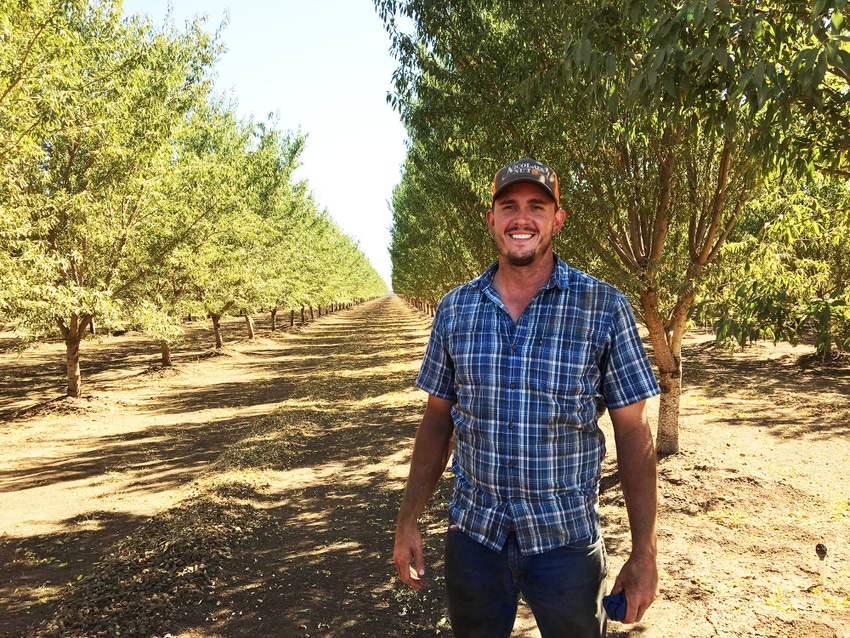
Biosolarization likely won’t be the ‘silver bullet’ in dealing with almond biomass, yet Chico, Calif.-area almond grower Rory Crowley believes it could be an important tool for growers in the future.
Biosolarization is an alternative to soil fumigation where soil amendments and the sun’s heat combine to reduce soil pests and weed seed populations.
Crowley, an Almond Board Leadership Class of 2016 alumnus, took on the biomass issue as the almond hull market began to shrink and estimates predicted a 30 percent increase in almond production by 2020-2021.
“This is just one avenue to explore,” Crowley said. “It’s likely growers will spread hulls and shells back into their orchards by default in the future so we are looking at systems to add value to this operation.”
Pest-weed seed control
Co-products of almond production must have a home, Crowley reasons, so why not determine if they can be useful in improving soil health while decreasing nematode and weed seed populations as an alternative to pre-plant chemical fumigation.
His five-acre project on planned almond ground ran throughout this summer. His data analysis phase is now underway to weigh the impact of biosolarization on almond biomass.
The soil at the site is infected with nematodes that can reduce almond tree growth and production, but the site’s proximity to housing and a child care facility make chemical fumigation application difficult at best.
Crowley’s aim is to offer a biomass use alternative that has value and can be easily adapted by other growers on their respective operations.
UC input
Crowley has been working with University of California (UC) researcher Christopher Simmons and his colleagues Jean VanderGheynst and James Stapleton. Crowley supplied soil samples along with hull and shell samples for initial testing to determine application rates and nematode population levels.
His trial involved two types of biomass - 100 percent Nonpareil hulls and a 70-30 percent mix of pollinator hulls and shells - both from a huller’s processing line.
After using a tub grinder to reduce the particle size to one inch or less, the biomass material was applied in a future orchard in tree rows in 10-foot-wide swaths at a rate of 16.7 tons per acre. The Butte County grower then tilled in the biomass 5-7 inches deep.
Working with a fumigation company, Crowley laid down drip tape 20 inches apart across the tilled swath along with totally impermeable film (TIF) clear plastic. Two timed irrigations sent moisture down five feet.
The sun and microorganisms went to work.

A bird’s eye view of California almond grower Rory Crowley’s five-acre biosolarization trial in Butte County studying soil health.
Biosolarization at work
Over the first few days of the process, he recorded soil temperatures in the first six inches of soil at 130-150 degrees Fahrenheit. The water activated the soil bacteria and soil amendment digestion began. Anaerobic conditions created soil conditions hostile to the targeted soil pests.
Crowley intended to leave the plastic on for 30 days to push acidic material generated by decomposition down further into the soil to kill the nematodes and weed seeds. The soil surface had dried somewhat after 30 days so another short irrigation re-moistened the top two feet of the soil, and pushed the acidity down even further. Tarping was removed at Day 42.
‘Beautiful soil’
What Crowley found was similar to compost.
“The soil was beautiful - fluffy tilth, dark, and smelled great,” the almond grower said.
There was a nearly complete breakdown of hull and shell material - seemingly more in the Nonpareil than the hull-shell mix.
UC’s Simmons says soil samples after the six-week trial are being analyzed at his laboratory. Crowley says the initial trial results will be presented at this year’s Almond Conference in December in Sacramento, Calif.
Simmons says the analysis could determine the impact of soil amendments on soil pests, plus the levels of available plant nutrients including nitrogen, phosphorus, and potassium.
Microbial activity?
Crowley, who is a conventional almond grower, is curious about the microbial activity after the treatment, and is also sending off material for testing at another lab.
“It is important to remember that this treatment is not indiscriminately killing beneficial microorganisms which is basically what chemical fumigation does,” said Crowley.
Simmons has estimated the experimental plot will add 1 to 1.25 percent organic matter to the topsoil and possibly enhance its water holding capacity and nutrient uptake.
Grower benefits
In a letter to the Almond Board, Crowley said that technologies or concepts which seek to diversify the hull and shell markets must have a timely transition from innovation to commercialization, and must be scalable for longer term, industry-wide adoption.
Crowley believes new technologies for almond biomass should add value to the hull and shell co-product with benefits for the grower. Such projects must also have the potential to make significant impact for hulling and shelling operations - using large amounts of hull and shell if traditional outlets are less viable or even unavailable.
With the support the Almond Board of California and the Western Center for Agricultural Health and Safety, Simmons and the UC Davis team will continue to monitor the properties of the treated soil and almond tree performance once planted early next year.
“This is an exciting time for the industry,” Crowley said.
“With the continued support of organizations like the Almond Board and the University of California, growers and hullers-shellers can be confident that no matter what comes our way that almonds will remain economically competitive on the global stage and environmentally friendly in our own backyards.”
About the Author(s)
You May Also Like




